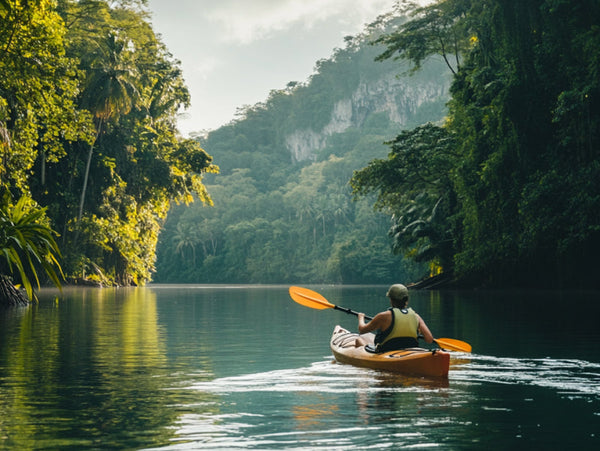A Guide to Kayaking with Kids

Introducing your children to a fun, healthy activity that’s near and dear to your heart can be a fantastic way to bond and make lifelong memories! Of course you want to provide an experience you’ll all cherish, so naturally, you have questions…
Where should we go? What do we need to bring? How do I keep them both safe and engaged?
We’ll help you sort through these and more concerns in this guide. Read on for handy tips and tricks that you can refer back to as your plan your family adventures.

Planning and Preparation
First of all, you need to determine the nature of your first outing. You’ll need to decide on the best boats and where to go. Furthermore, we don’t want to overwhelm younger kids with long, tiring journeys before the paddling even begins. It’s usually best to start small and work your way up as they get more comfortable with kayaking and everything it entails.
Choosing the Right Vessel
If your child is already somewhat independent and a strong swimmer, they may do well in their own kids kayak (of course, use your judgement). You could also paddle with them sitting in the forward seat of a tandem kayak. Alternatively, many kids aged four to seven can sit at the front of your personal kayak on small flatwater trips. For very young kids who won’t be paddling, a canoe may be the best choice.

Where to Paddle?
Try to find a destination that’s less than an hour away if possible. Unless you’re an advanced whitewater paddler and have an adventurous child who’s already a strong swimmer, it’s a good idea to start out in flatwater with weak to no currents. Ponds, lakes, and calm rivers and creeks are a great bet.
If you’re dealing with some degree of current, start out by paddling upstream (against the flow) when energy and excitement is high. That way, when you’re ready to turn around, you don’t have to fight the current with a tired kid on your hands; you can just relax, enjoy the view, and drift back to the take out.
Safety Considerations
Now that you’ve picked the perfect spot, it’s time to talk with your child about expectations, go over important safety points, and decide what to pack.

Outlining Expectations
Just like with an adults-only outing, you want to ensure that everyone involved is aware of the plan. With adults, this briefing should include things like time of departure and return (especially important if you’re setting shuttle and not paddling back to the put-in).
With young children, you can stick to brief, age-appropriate important points. This can include a general description of where you’re going as well as overall and any location-specific safety considerations.
The length of the trip is going to depend on many different factors, including your child’s age, physical strength and stamina, swimming ability, and comfort level with the type of environment you’ll be exploring.
And of course, be sure to come up with plans for what you’ll do in case of emergencies, inclement weather, or unforeseen circumstances. Engaging older kids in these plans is a great way to foster responsibility and respect for the sport and nature.

What to Bring
Aside from the obvious gear like boats, paddles, PFDs, and folding anchors for stationary wildlife viewing or fishing, you’ll need to bring some extras.
Be sure to pack enough water, snacks, and meals for everyone.
Don’t forget sun protection.
A throw bag for each adult and tow lines for each boat. (We strongly recommend taking ACA safety classes and regularly practicing to properly use these items.)
Have a charged cell phone in a watertight container or dry bag to use in case of emergencies or changed plans.

Engagement
An effective way to foster kids’ excitement is to be sure they feel ownership in the planning and activity itself. To do this, focus on your child’s interests:
Are they into science and wildlife? Get a flower and plant identification book specific to the destination. Go over it with them, and ask them what they hope to find. Maybe they’d like their own field notebook to document the journey during breaks.
Do they love a physical challenge? Come up fun, safe games to play in your vessel of choice, like kayak races or a lake-friendly game of sharks and minnows.
Reflect on the trip and plan the next one! It’s important to reflect on the fun you had as a family, whether it’s pouring over photos and notes or having them help plan the next adventure.
Now that you have some guidelines for introducing your kids to kayaking, get out there and have fun!
Spread The Word & Pin It 😊
Disclosure: BEST Marine and Outdoors is a participant in the Amazon Services LLC Associates Program, an affiliate advertising program designed to provide a means for sites to earn advertising fees by advertising and linking to Amazon.com. This means if you click on the links above and purchase an item, we will receive an affiliate commission at no extra cost to you.
1 Response
Leave a comment
Comments will be approved before showing up.
Also in Blog

How to Choose the Right Kayak Anchor
Choosing the right kayak anchor can make all the difference when it comes to staying steady on the water. This guide walks you through everything you need to know about selecting the perfect folding kayak anchor

What To Do When Your Kayak Capsizes
Although kayaks are designed for stability no matter the conditions, accidents happen and knowing what to do can help you avoid an unpleasant experience. Preparedness and technique are key components to controlling a sometimes scary situation.



Kathryn Shea
March 12, 2020
Very helpful information !